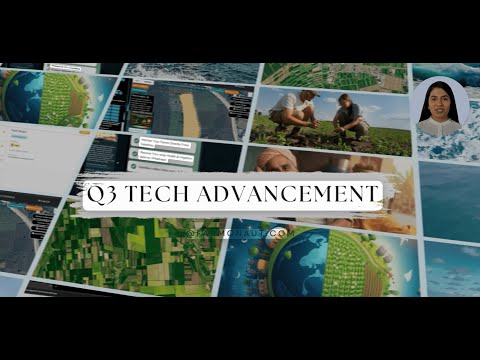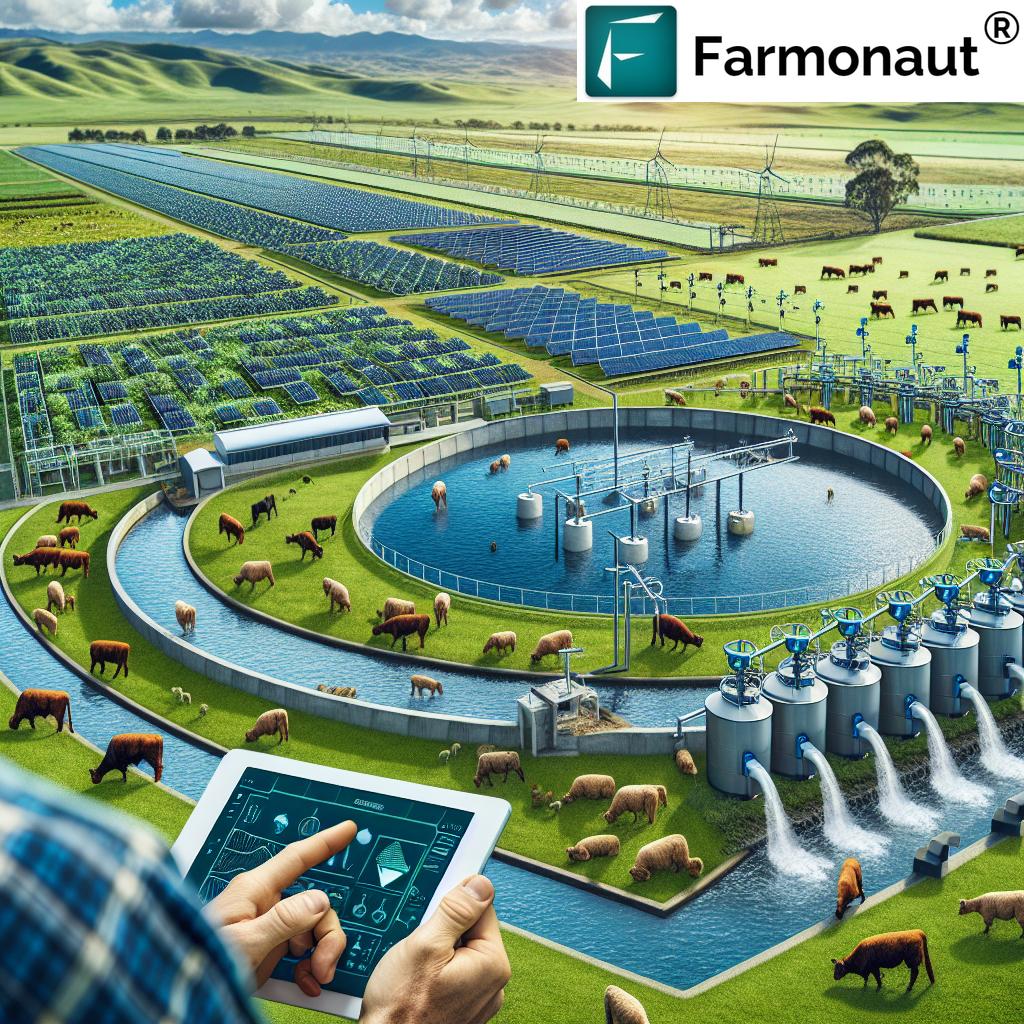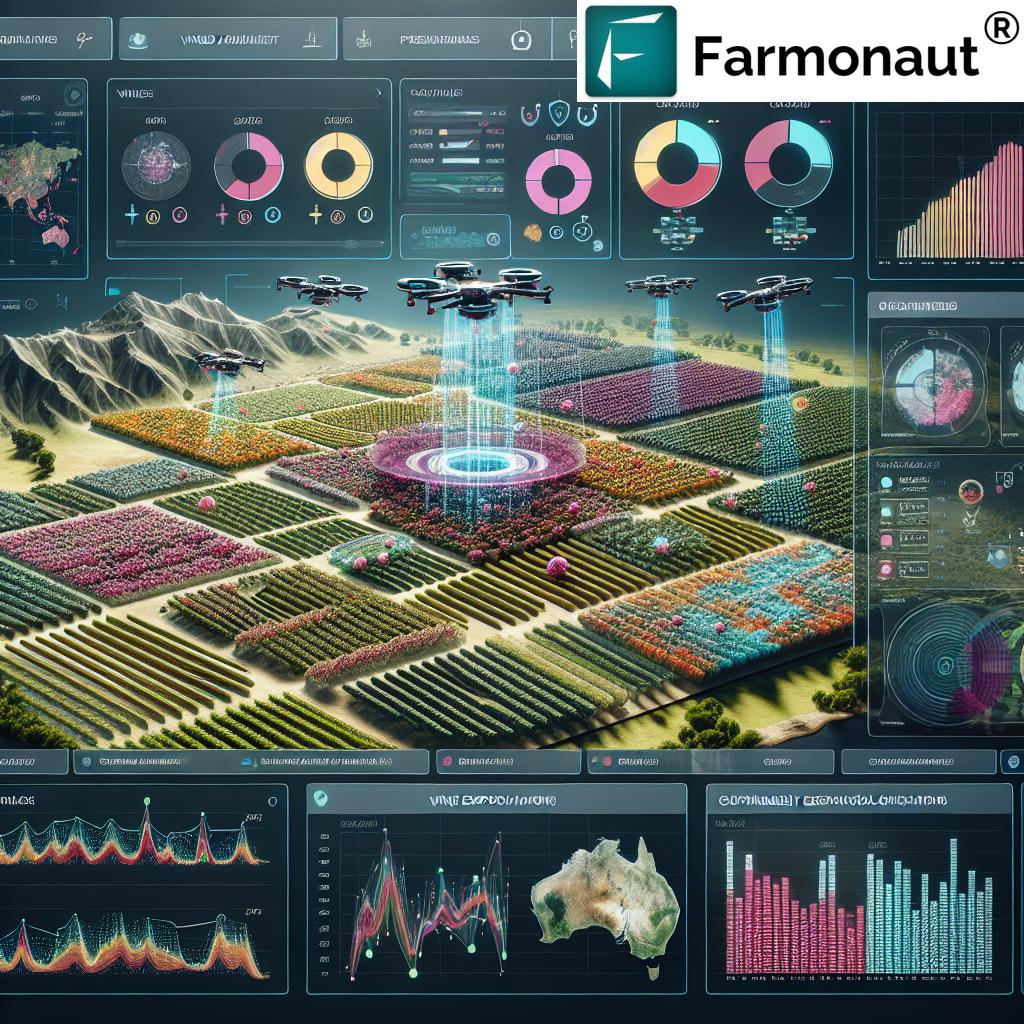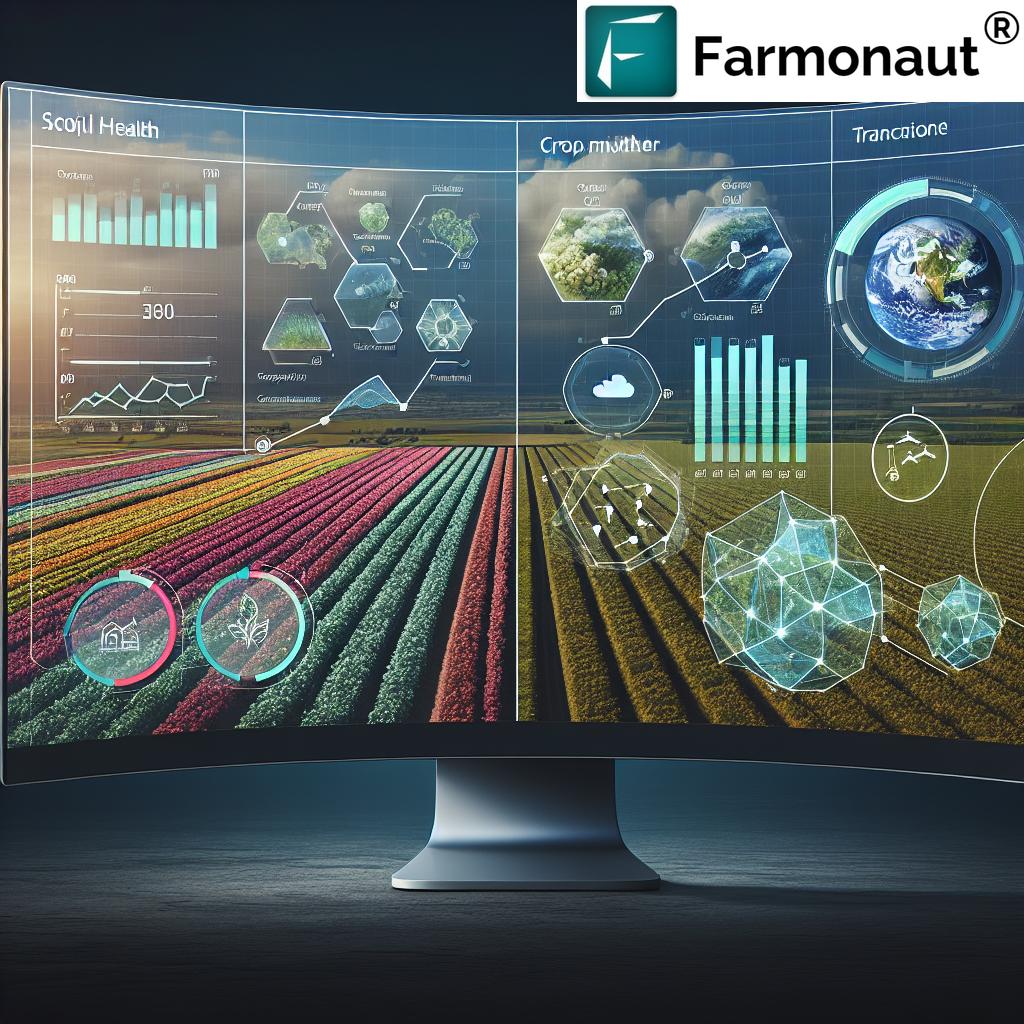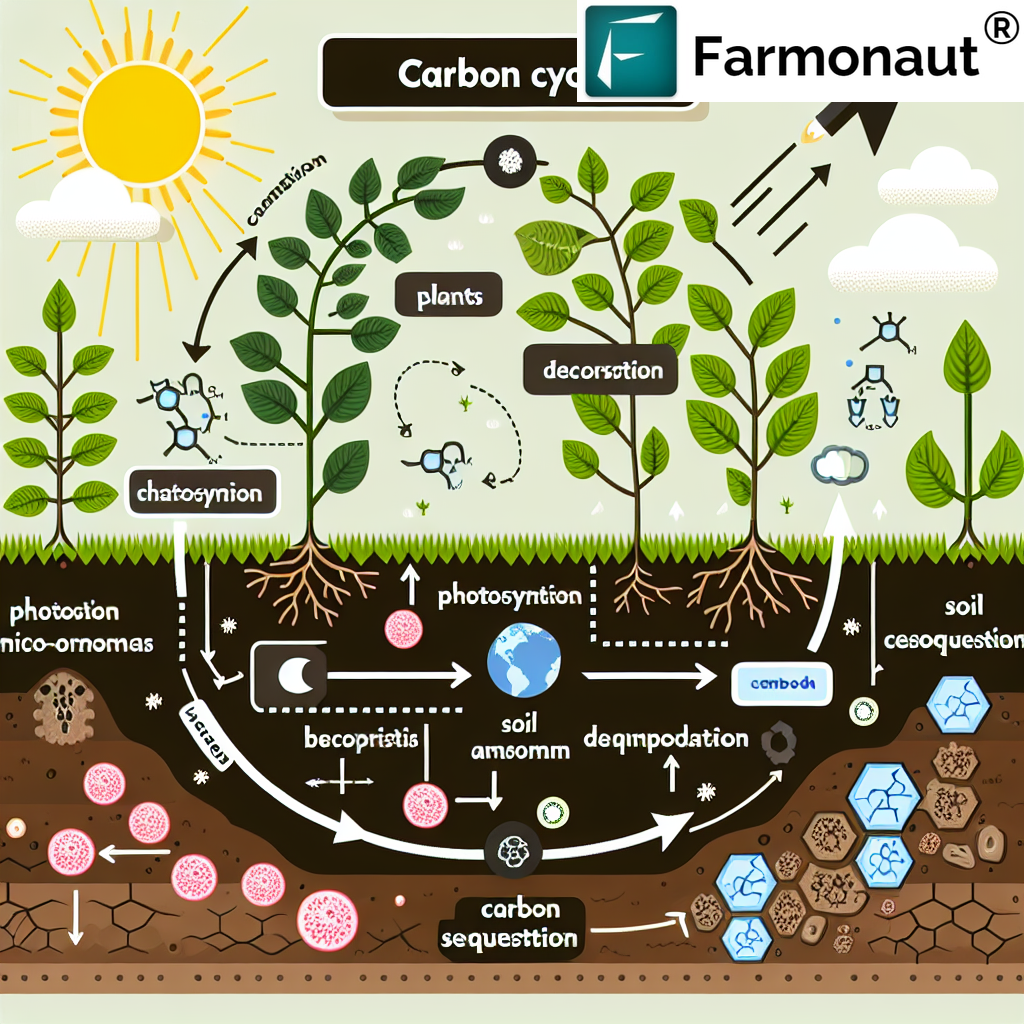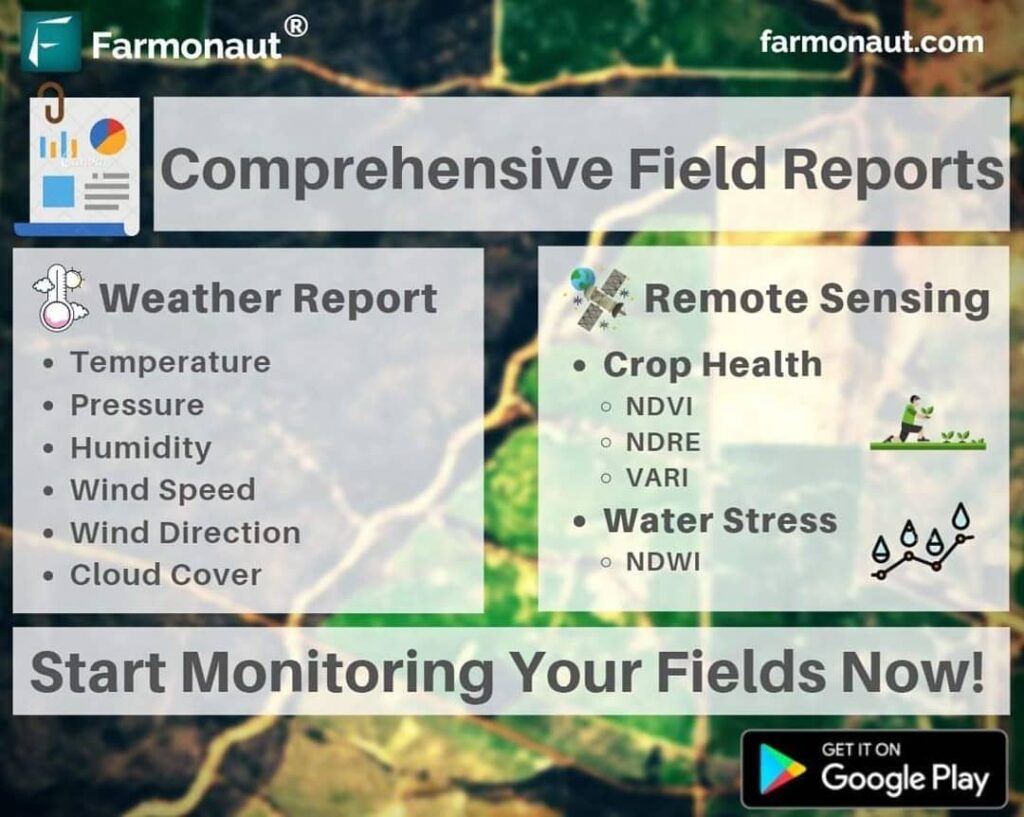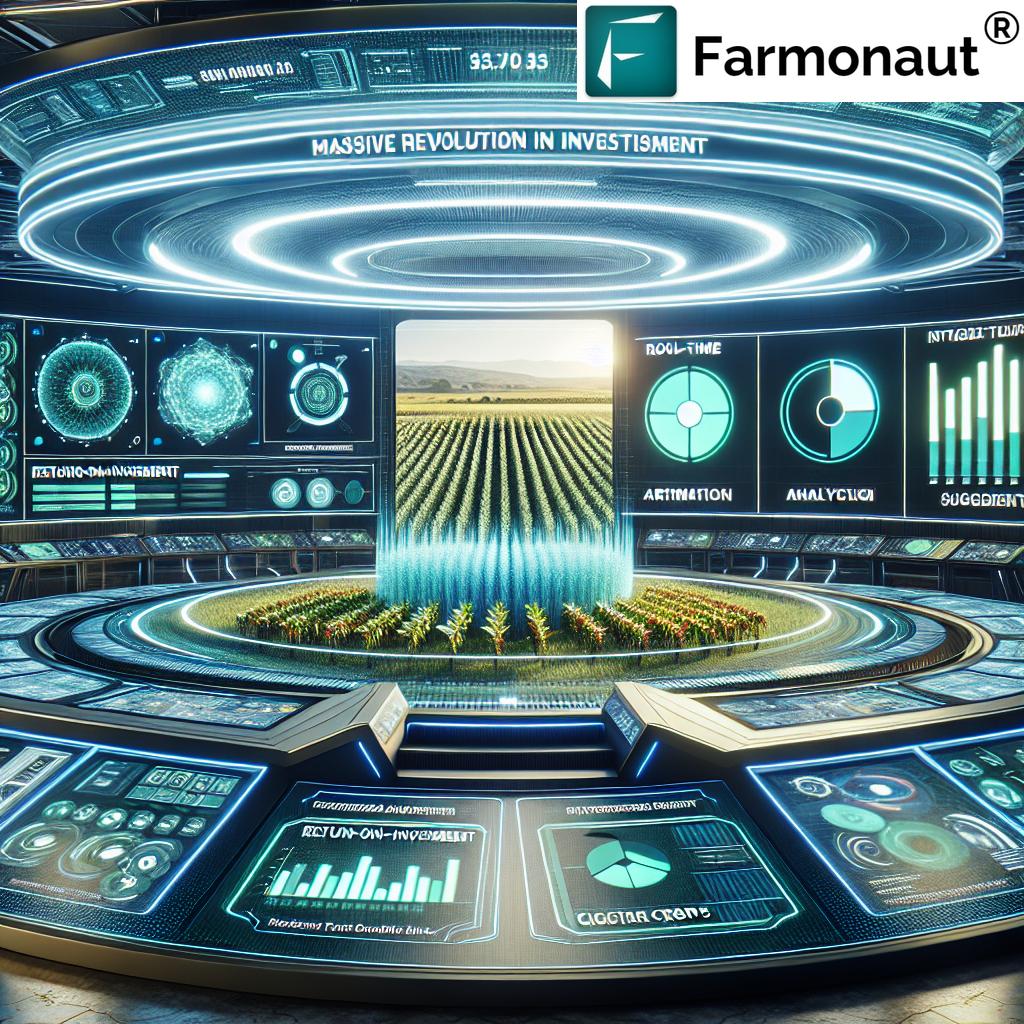Unlocking Agricultural Market Trends: Farmonaut’s Precision Farming Guide for Data-Driven Crop Yield Prediction
“Farmonaut’s precision farming guide analyzes agricultural market trends across 3 timeframes: short, medium, and long-term.”
Welcome to our comprehensive guide on unlocking agricultural market trends and leveraging precision farming techniques for data-driven crop yield prediction. As representatives of Farmonaut, we’re excited to share our expertise in agricultural data analytics and smart farming solutions to help you navigate the ever-evolving landscape of modern agriculture.
In today’s rapidly changing agricultural sector, staying ahead of market trends and adopting cutting-edge technologies is crucial for success. This guide will delve into the intricate world of agricultural commodity prices, crop yield prediction methods, and the revolutionary impact of satellite crop monitoring on farm management.
The Power of Precision Agriculture Technologies
Precision agriculture technologies have transformed the way we approach farming. By harnessing the power of data and advanced analytics, farmers can now make more informed decisions, optimize resource allocation, and significantly improve crop yields. Let’s explore some of the key technologies shaping the future of agriculture:
- Satellite Crop Monitoring: This technology allows farmers to track crop health, growth patterns, and potential issues from space, providing a bird’s-eye view of their fields.
- Weather Forecasting for Farmers: Accurate, localized weather predictions help in planning crucial farm activities and mitigating climate-related risks.
- Farm Management Software: Integrated platforms that streamline operations, from planting to harvest, enhancing overall farm efficiency.
- Agricultural Data Analytics: Advanced algorithms that process vast amounts of data to generate actionable insights for improved decision-making.
At Farmonaut, we’re at the forefront of these technological advancements, offering a suite of tools designed to make precision agriculture accessible and affordable for farmers worldwide.
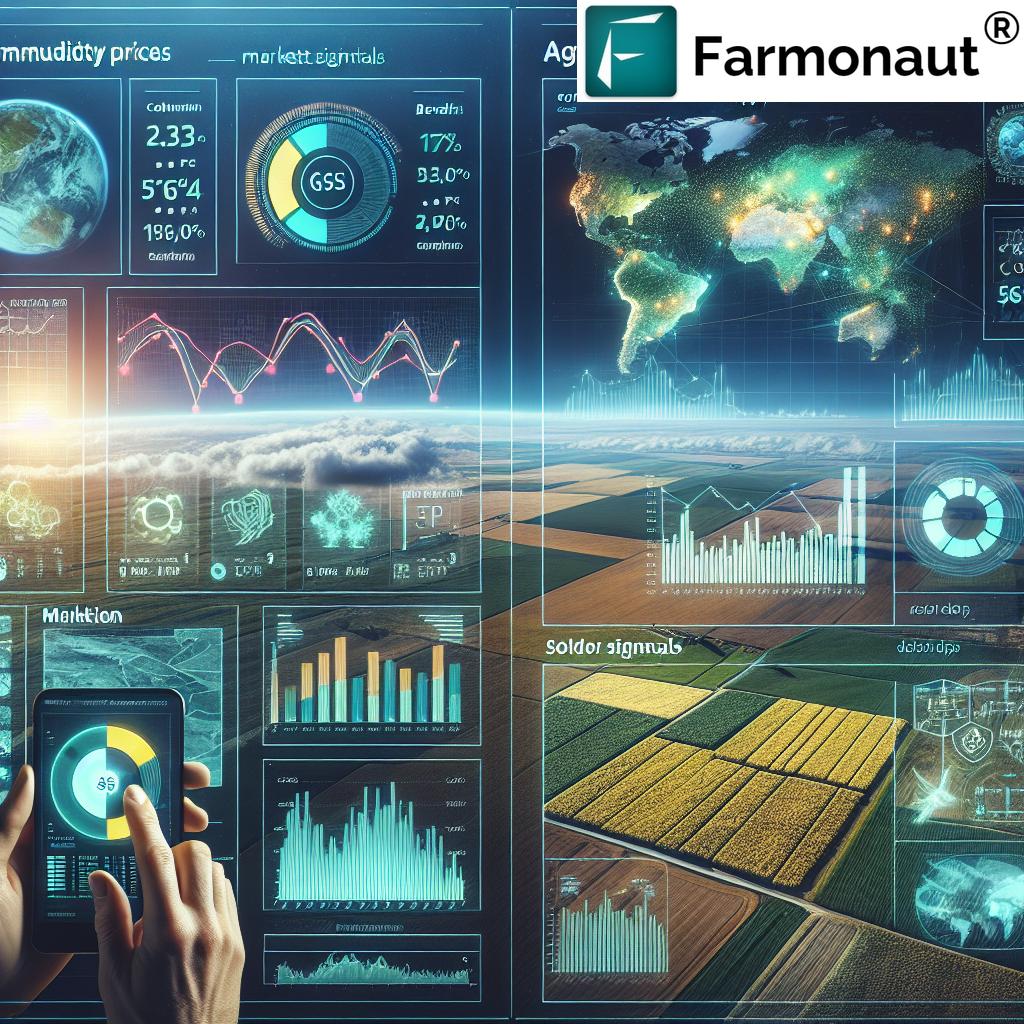
Understanding Agricultural Market Trends
To make informed decisions in agriculture, it’s crucial to understand market trends across different timeframes. Let’s break down the key indicators and their implications:
Short-Term Market Trends
Short-term trends in agricultural markets are often influenced by immediate factors such as weather events, supply chain disruptions, or sudden changes in demand. These trends can cause significant price volatility and require quick decision-making.
- Price Signals: Daily and weekly price movements can indicate short-term supply and demand imbalances.
- Volume Indicators: Sudden spikes or drops in trading volume may signal important market shifts.
- Technical Charts: Short-term moving averages and resistance/support levels help identify immediate price trends.
Medium-Term Market Trends
Medium-term trends typically span several months to a year and are influenced by factors such as seasonal patterns, government policies, and global economic conditions.
- Seasonal Patterns: Many agricultural commodities follow predictable seasonal price patterns.
- Policy Changes: Government interventions or trade agreements can significantly impact medium-term market dynamics.
- Global Economic Indicators: Factors like GDP growth, inflation rates, and currency exchange rates play a role in shaping medium-term trends.
Long-Term Market Trends
Long-term agricultural market trends are driven by structural changes in the industry, technological advancements, and shifting consumer preferences.
- Technological Adoption: The increasing use of precision agriculture technologies is reshaping long-term productivity trends.
- Climate Change: Long-term climate patterns are altering crop yields and farming practices globally.
- Consumer Behavior: Growing demand for organic and sustainably produced foods is influencing long-term market trends.
By analyzing these trends across different timeframes, farmers and investors can develop more robust strategies for crop planning, resource allocation, and risk management.
Crop Yield Prediction: The Data-Driven Approach
Accurate crop yield prediction is a cornerstone of modern agriculture, enabling better resource management and financial planning. At Farmonaut, we leverage advanced data analytics and satellite technology to provide precise yield forecasts.
Key Factors in Crop Yield Prediction
- Historical Yield Data: Analyzing past performance helps establish baseline expectations.
- Weather Patterns: Integrating real-time and forecasted weather data improves prediction accuracy.
- Soil Health: Assessing soil nutrient levels and moisture content is crucial for yield estimation.
- Satellite Imagery: Remote sensing provides valuable insights into crop health and growth stages.
- Agronomic Practices: Considering factors like planting dates, crop rotation, and fertilizer use refines predictions.
Our advanced algorithms process these diverse data points to generate highly accurate yield predictions, helping farmers make data-driven decisions throughout the growing season.
The Role of Satellite Crop Monitoring in Modern Agriculture
“Satellite crop monitoring and weather forecasting are among the key technologies shaping modern data-driven farm management.”
Satellite crop monitoring has revolutionized the way we observe and manage agricultural lands. This technology offers numerous benefits:
- Real-Time Crop Health Assessment: Satellite imagery allows farmers to detect issues like pest infestations or nutrient deficiencies early.
- Precision Resource Application: By identifying areas of stress or low productivity, farmers can apply resources like water and fertilizers more efficiently.
- Yield Estimation: Advanced algorithms can estimate crop yields based on satellite data, helping with harvest planning and market forecasting.
- Environmental Monitoring: Satellite data aids in tracking changes in land use, deforestation, and the impact of climate change on agriculture.
At Farmonaut, we provide cutting-edge satellite crop monitoring services, making this powerful technology accessible to farmers of all scales. Our platform integrates satellite data with on-ground information to provide actionable insights for improved farm management.
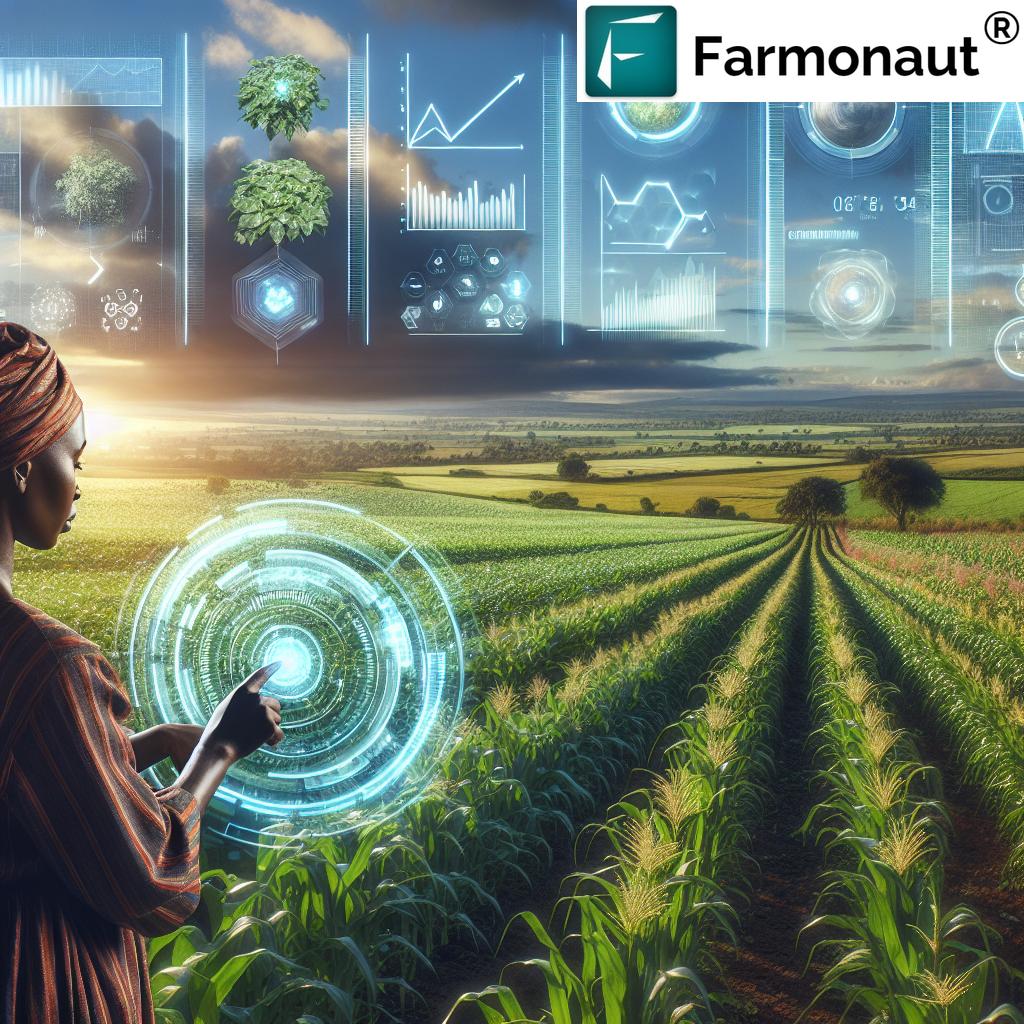
Weather Forecasting for Farmers: A Game-Changer in Agriculture
Accurate weather forecasting is crucial for successful farming operations. Modern forecasting techniques have significantly improved the ability to predict weather patterns, benefiting farmers in numerous ways:
- Planting Decisions: Knowing upcoming weather conditions helps farmers optimize planting dates.
- Irrigation Management: Accurate rainfall predictions allow for more efficient water use.
- Pest and Disease Control: Weather forecasts help in timing the application of pesticides and fungicides for maximum effectiveness.
- Harvest Planning: Long-range forecasts assist in planning harvest activities and logistics.
Farmonaut’s weather forecasting services provide localized, high-precision weather data tailored specifically for agricultural needs. By integrating this data with our other farm management tools, we offer a comprehensive solution for weather-smart farming.
Smart Farming Solutions: The Future of Agriculture
Smart farming solutions are transforming agriculture into a high-tech industry. These innovative approaches combine various technologies to optimize farm operations:
- IoT Sensors: Network-connected sensors provide real-time data on soil moisture, temperature, and other crucial parameters.
- Drone Technology: Drones offer detailed aerial imagery and can even assist in tasks like crop spraying.
- AI and Machine Learning: Advanced algorithms process vast amounts of data to provide predictive insights and recommendations.
- Robotics: Automated systems are increasingly used for tasks like planting, weeding, and harvesting.
Farmonaut’s platform integrates seamlessly with various smart farming technologies, providing a unified interface for managing all aspects of modern agriculture.
Sustainable Agriculture Practices in the Digital Age
Sustainability is no longer just a buzzword in agriculture; it’s a necessity. Digital technologies are playing a crucial role in promoting sustainable farming practices:
- Precision Resource Management: Data-driven approaches minimize waste and optimize the use of water, fertilizers, and pesticides.
- Soil Health Monitoring: Advanced sensors and satellite data help maintain soil quality and prevent degradation.
- Carbon Footprint Reduction: Smart farming practices can significantly reduce the carbon footprint of agricultural operations.
- Biodiversity Conservation: Precision agriculture allows for more targeted interventions, preserving natural habitats within and around farmlands.
At Farmonaut, sustainability is at the core of our mission. Our tools are designed to help farmers adopt more sustainable practices while maintaining profitability.
Agricultural Data Analytics: Turning Information into Action
The true power of precision agriculture lies in its ability to turn vast amounts of data into actionable insights. Agricultural data analytics involves:
- Data Collection: Gathering information from various sources including satellites, sensors, and historical records.
- Data Processing: Cleaning and organizing raw data for analysis.
- Advanced Analytics: Applying statistical models and machine learning algorithms to identify patterns and trends.
- Visualization: Presenting insights in easy-to-understand formats like charts and maps.
- Predictive Modeling: Using historical data to forecast future trends and outcomes.
Farmonaut’s advanced analytics platform processes terabytes of data to provide farmers with clear, actionable insights for improved decision-making.
Market Volatility and Risk Management in Agriculture
Agricultural markets are known for their volatility, influenced by factors ranging from weather events to global economic conditions. Effective risk management strategies are essential for farmers and agribusinesses:
- Diversification: Growing a variety of crops or engaging in mixed farming can help mitigate market risks.
- Futures and Options: Using financial instruments to hedge against price fluctuations.
- Insurance: Crop insurance and other risk transfer mechanisms provide a safety net against unforeseen events.
- Data-Driven Decision Making: Utilizing market intelligence and predictive analytics to make informed choices.
Our platform at Farmonaut provides real-time market data and predictive analytics to help farmers navigate market volatility and make informed risk management decisions.
The Impact of Global Events on Agricultural Markets
Global events can have significant and sometimes unexpected impacts on agricultural markets. Understanding these influences is crucial for long-term planning:
- Trade Policies: International trade agreements and tariffs can dramatically affect commodity prices and market access.
- Geopolitical Events: Political instability or conflicts in key agricultural regions can disrupt global supply chains.
- Economic Shifts: Changes in global economic conditions can impact demand for agricultural products.
- Technological Breakthroughs: Innovations in areas like genetic modification or vertical farming can reshape entire sectors of the industry.
At Farmonaut, we continuously monitor global trends and integrate this information into our market analysis and forecasting tools.
Emerging Trends in Agricultural Technology
The agricultural technology landscape is constantly evolving. Here are some emerging trends to watch:
- Blockchain in Agriculture: Enhancing traceability and transparency in the food supply chain.
- Vertical Farming: Innovative urban farming solutions for sustainable food production in cities.
- Gene Editing: Developing crop varieties with enhanced traits for resilience and productivity.
- Autonomous Farm Equipment: Self-driving tractors and harvesters increasing efficiency and reducing labor costs.
- 5G Technology: Enabling faster, more reliable connectivity for IoT devices and real-time data processing in rural areas.
Farmonaut stays at the forefront of these technological advancements, continually updating our platform to incorporate the latest innovations in agtech.
Comparative Analysis: Agricultural Market Trends and Precision Farming Metrics
| Timeframe | Agricultural Commodity Prices (est. % change) | Crop Yield Prediction Accuracy (est. %) | Satellite Crop Monitoring Adoption (est. %) | Weather Forecasting Accuracy for Farmers (est. %) | Smart Farming Solution Implementation (est. %) |
|---|---|---|---|---|---|
| Short-term (0-6 months) | +/- 5% | 85% | 30% | 90% | 20% |
| Medium-term (6-18 months) | +/- 10% | 90% | 45% | 92% | 35% |
| Long-term (18+ months) | +/- 15% | 95% | 60% | 95% | 50% |
This table provides a snapshot of key agricultural market trends and precision farming metrics across different timeframes. It illustrates the potential for increased accuracy and adoption of advanced farming technologies over time, as well as the inherent volatility in agricultural commodity prices.
Integrating Precision Agriculture into Your Farming Operations
Adopting precision agriculture technologies can seem daunting, but the benefits are substantial. Here’s a step-by-step guide to integrating these technologies into your farming operations:
- Assess Your Needs: Identify the specific challenges and goals for your farm.
- Start Small: Begin with one or two technologies and gradually expand.
- Invest in Training: Ensure you and your team are well-versed in using new technologies.
- Analyze and Adapt: Regularly review the data and insights provided by your precision agriculture tools.
- Stay Informed: Keep up with the latest advancements in agricultural technology.
Farmonaut offers comprehensive support and training to help farmers seamlessly integrate our precision agriculture solutions into their operations.
The Future of Agriculture: Predictions and Possibilities
As we look to the future, several trends are likely to shape the agricultural landscape:
- AI-Driven Farming: Artificial intelligence will play an increasingly central role in farm management and decision-making.
- Climate-Resilient Agriculture: Developing crops and farming practices adapted to changing climate conditions will be crucial.
- Personalized Nutrition: Tailoring crop production to meet specific nutritional needs and preferences.
- Circular Agriculture: Emphasizing closed-loop systems that minimize waste and maximize resource efficiency.
- Space Agriculture: Exploring possibilities for food production in space, with potential applications for Earth-based farming.
At Farmonaut, we’re committed to staying at the forefront of these developments, continually evolving our platform to meet the changing needs of farmers in an increasingly complex and technologically advanced world.
Conclusion: Embracing the Data-Driven Agricultural Revolution
As we’ve explored throughout this guide, the agricultural sector is undergoing a profound transformation driven by data, technology, and a growing emphasis on sustainability. From satellite crop monitoring to AI-powered yield predictions, the tools available to modern farmers are more powerful and accessible than ever before.
At Farmonaut, we’re proud to be at the forefront of this agricultural revolution, providing farmers with the tools and insights they need to thrive in an ever-changing landscape. By embracing precision agriculture technologies and data-driven decision-making, farmers can not only improve their productivity and profitability but also contribute to a more sustainable and resilient global food system.
We invite you to explore our range of services and join us in shaping the future of agriculture. Whether you’re a small-scale farmer or a large agribusiness, Farmonaut has the solutions to help you unlock the full potential of your farming operations.
Ready to revolutionize your farming practices? Explore Farmonaut’s precision agriculture solutions today!
For developers interested in integrating our powerful agricultural data into their own applications, check out our API and API Developer Docs.
Farmonaut Subscriptions
Frequently Asked Questions (FAQ)
Q: What is precision agriculture?
A: Precision agriculture is an approach to farm management that uses information technology and data analysis to optimize crop yields and reduce resource waste. It involves technologies like GPS guidance, control systems, sensors, robotics, drones, autonomous vehicles, variable rate technology, GPS-based soil sampling, and automated hardware.
Q: How does satellite crop monitoring work?
A: Satellite crop monitoring uses imagery from satellites to observe and analyze crop health, growth stages, and field conditions. These images are processed using advanced algorithms to provide insights on vegetation health, soil moisture, and potential issues like pest infestations or nutrient deficiencies.
Q: Can Farmonaut’s solutions be used for small-scale farming?
A: Absolutely! Farmonaut’s solutions are designed to be scalable and accessible to farmers of all sizes. Our platform offers affordable options that can benefit small-scale farmers by providing valuable insights and tools to improve productivity and efficiency.
Q: How accurate are crop yield predictions using Farmonaut’s technology?
A: While the accuracy can vary depending on factors like crop type and available data, our advanced algorithms typically achieve high levels of accuracy in crop yield predictions. We continually refine our models to improve accuracy over time.
Q: What types of data does Farmonaut use for its agricultural analytics?
A: Farmonaut integrates various data sources including satellite imagery, weather data, soil information, historical yield data, and on-ground sensor data where available. This comprehensive approach allows for more accurate and insightful analytics.
Q: How often is the satellite imagery updated on Farmonaut’s platform?
A: The frequency of satellite imagery updates can vary depending on the specific service package and geographical location. Generally, we provide updates every few days to ensure timely and relevant information for farm management decisions.
Q: Does Farmonaut offer support for implementing its technologies?
A: Yes, we provide comprehensive support and training to help farmers integrate our solutions into their operations. Our team is dedicated to ensuring that users can effectively leverage our technologies to improve their farming practices.
For more information about our services or to get started with Farmonaut’s precision agriculture solutions, please visit our website or contact our support team.


